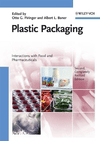Two percent milk or skim milk? Fresh or frozen vegetables? Name brand or store brand?
Consumers are bombarded with decisions every time they go to the grocery store. And then upon checkout, they have another decision to make – paper or plastic?
Sure, this phrase is often synonymous with choosing between what material of bag to carry newly bought items in. But with the rise of flexible packaging, shoppers are constantly making a choice between paper and plastic product packaging, as well.
While a decision to choose products packaged in flexible materials over paper is based on various factors – personal preference, familiarity, cost, convenience, attractiveness, etc. – a number of industry experts argue that the sustainable properties of plastic, particularly plastic film labels, make the material a prime choice for consumers, manufacturers and brands that seek an eco-friendly alternative.
According to Understanding Plastic Film: Its Uses, Benefits and Waste Management Options, a report prepared by Headly Pratt Consulting for the American Plastics Council, plastic film does not present environmental issues when it reaches the landfill because the material does not cause leachate problems or significantly add to the production of methane, which contributes to global warming. Film is also preferable to other types of waste because it is easily compressible and takes up less space.
“If you allow paper to decompose, it’ll break up into small, little pieces, but whatever ink is on the paper remains on the paper and remains in the ground water,” says Ron Ducharme, product manager at FLEXcon, a Spencer, Massachusetts-based company that manufactures coated and laminated films and adhesives used in graphics applications, manufactured goods and new products.
While there is currently no clear cut way to recycle plastic film and 100 percent compostable film is still a “generation away,” Ducharme adds that there are ways to get film out of the waste stream, such as encouraging end-users to remove and recycle film labels separate from their containers.
“Whether it’s a polyester container or a polypropylene container, there are adhesives that are out there that will allow you to remove the labels from the bottle, float them off and recycle the bottles in one stream and then the labels in another stream,” he says. “When doing that with paper, what ends up happening is that the paper jams up all the filters and all of the system. In a compost pile of paper, you’ll end up with little chips of ink or shards of ink, so that becomes a problem.”
Once films are recycled in their designated spots, Ducharme says the ink on the materials can be extruded and burned at a much higher BTU than paper to generate clean power. The rest of the packaging can also be burned, reclaimed or chipped up into smaller pieces to create new end products.
According to the 2014 Postconsumer Plastic Bag & Film Recycling Report, which was prepared by Moore Recycling Associates Inc. for the American Chemistry Council, there is an estimated 836 million pounds per year of plastic film reclamation capacity in the U.S. that includes washing or processing unwashed material directly into regrind, agglomerate or end products. These end products primarily consist of composite lumber, film and sheet and goods such as marine products, agricultural products, crates, buckets and pellets.
“Everybody has a responsibility to the world, the globe, the community to make sure everything out there is as safe as possible, can be reclaimed as much as possible and be put back into the waste stream,” Ducharme says.
Whether it’s the low-impact it has on landfills or the ease of transforming it into new materials and products, film provides a variety of properties that make environmental responsibility a possibility. It’s just a matter of educating people on how to remove it from the waste stream, something that has already been largely accomplished with paper.
FLEXcon
(508) 885-8200
www.flexcon.com










